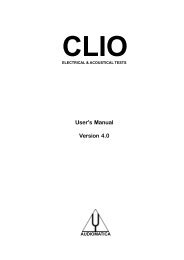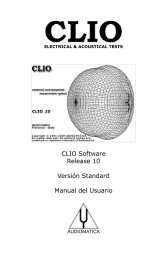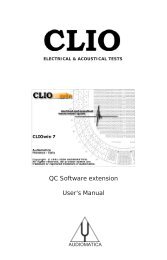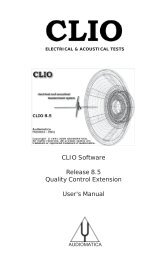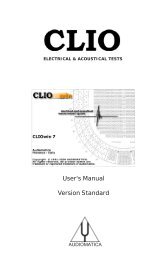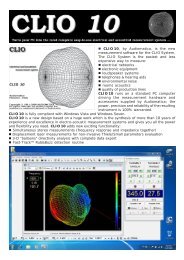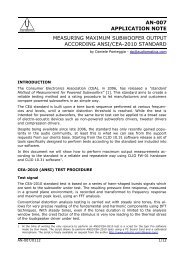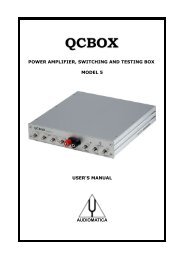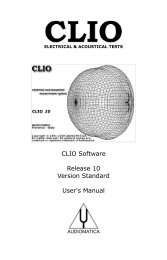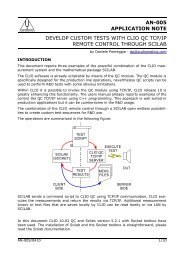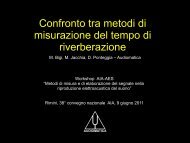CLIOwin 6.5 PCI User's Manual - Audiomatica Srl
CLIOwin 6.5 PCI User's Manual - Audiomatica Srl
CLIOwin 6.5 PCI User's Manual - Audiomatica Srl
You also want an ePaper? Increase the reach of your titles
YUMPU automatically turns print PDFs into web optimized ePapers that Google loves.
12.3 WATERFALL BASICS<br />
Figure 12.2<br />
Within the waterfall settings dialog (Fig. 12.2) it is possible to configure many waterfall<br />
parameters. But, since the calculation relies on externally available data, it also<br />
captures some settings from the data source itself. When executing CSD and ETF<br />
waterfalls the data source is the MLS control panel, when displaying files the data source<br />
is, obviously, the set of files. It is possible to save and load from disk executed waterfalls.<br />
One automatic setting is Y scaling. The waterfall amplitude scale is always dB relative;<br />
the routine try to evaluate the maximum value within all the data to be represented and<br />
references all other values to this.<br />
The first setting encountered is Mode that selects between the available modes: CSD,<br />
ETF and File. Follow a basic introduction to the three different modes.<br />
12.3.1 CSD AND ETF MODES SETTINGS AND OPERATION<br />
Number of Spectra<br />
Selects the number of data slices to display.<br />
Time Shift (ms)<br />
Selects the time between two consecutive spectra.<br />
Window Rise Time (ms)<br />
Selects the rise time of the data selecting window. Valid only for CSD.<br />
Reference<br />
If checked the waterfall spectra will be reference to the rearmost one.<br />
As already said, the data source for a CSD or ETF waterfall is the MLS control panel; when<br />
in these modes, the Go button becomes active only if there is an MLS measurement<br />
active, i.e.just executed or loaded from disk. The waterfall captures the following MLS<br />
settings: frequency range, if MLS has a zoomed curve than waterfall will take the<br />
selected zoom as frequency range to display; smoothing, the current MLS smoothing<br />
factor is also applied to the calculated data slices; start time, the Start Window value<br />
selected in the MLS impulse response represents time zero for the waterfall; stop time,<br />
the Stop Window value selected in the MLS impulse response represents the last<br />
processed CSD slice unless a different Time Shift has been selected.<br />
You can interactively switch between the MLS and Waterfall control panels to change<br />
the MLS settings that affect waterfall.<br />
CSD (Cumulative Spectral Decay) is intended primarily for anechoic loudspeaker<br />
118 Chapter 12 - Waterfall



